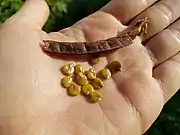| Senna hebecarpa | |
|---|---|
 | |
| Scientific classification | |
| Kingdom: | Plantae |
| Clade: | Tracheophytes |
| Clade: | Angiosperms |
| Clade: | Eudicots |
| Clade: | Rosids |
| Order: | Fabales |
| Family: | Fabaceae |
| Subfamily: | Caesalpinioideae |
| Genus: | Senna |
| Species: | S. hebecarpa |
| Binomial name | |
| Senna hebecarpa | |
| Synonyms | |
|
Cassia hebecarpa Fernald | |
Senna hebecarpa, with the common names American senna[4] and wild senna, is a species of legume native to eastern North America.[3][2][5] [6]
Description
Senna hebecarpa grows as a sparsely branched perennial plant. It has alternate, compound leaves.[7]
Clusters of light yellow to orange flowers bloom from July to August in North America.[7]
 Fruit and seeds
Fruit and seeds
Distribution and habitat
The plant is found from the Great Lakes region and Maine southwards through the Eastern United States, in the Appalachian Mountains and Atlantic Plains, to Georgia.[3][8]
It is found in moist open woodlands, and in disturbed areas.[8]
Ecology
It is a larval host and nectar source for the Cloudless Giant Sulphur (Phoebis sennae) butterfly.[7] It is also of special value to native bumble bees.[7] [9]
Conservation status in the United States
It is endangered in Massachusetts and New Hampshire, threatened in Vermont, as historical in Rhode Island,[10] and as threatened in Connecticut.[11]
Uses
Senna hebecarpa is cultivated as an ornamental plant, for use as a perennial wildflower and flowering shrub in traditional and wildlife gardens, in natural landscaping projects, and for habitat restoration projects.[7][5][6]
Native American ethnobotany
The Cherokee use an infusion of the plant for various purposes, including taking it for cramps, heart trouble, giving it to children and adults as a purgative and for fever, and taking it for 'blacks' (hands and eye sockets turn black). They also give an infusion of the root specifically to children for fever. They use a poultice the root for sores, and they use a compound infusion for fainting spells. They also use a compound for pneumonia.[12] The Iroquois use the plant as a worm remedy and take a compound decoction as a laxative.[13]
References
- ↑ NatureServe (1 September 2023). "Senna hebecarpa". NatureServe Network Biodiversity Location Data accessed through NatureServe Explorer. Arlington, Virginia: NatureServe. Retrieved 19 September 2023.
- 1 2 ITIS Standard Report Page: Senna hebecarpa
- 1 2 3 United States Department of Agriculture (USDA) (2014): Senna hebecarpa. Retrieved 8-24-2014.
- ↑ USDA, NRCS (n.d.). "Senna hebecarpa". The PLANTS Database (plants.usda.gov). Greensboro, North Carolina: National Plant Data Team. Retrieved 10 November 2015.
- 1 2 Blanchan, N. (1916): Wild Flowers: An Aid to Knowledge of our Wild Flowers and their Insect Visitors. TXT fulltext at Project Gutenberg
- 1 2 Blanchan, N. (1917): Wild Flowers Worth Knowing. HTML or TXT fulltext at Project Gutenberg
- 1 2 3 4 5 "Lady Bird Johnson Wildflower Center - The University of Texas at Austin". www.wildflower.org.
- 1 2 "Senna hebecarpa". Germplasm Resources Information Network. Agricultural Research Service, United States Department of Agriculture. Retrieved 16 January 2018.
- ↑ The Xerces Society for Invertebrate Conservation: Pollinator Conservation Program
- ↑ "Plants Profile for Senna hebecarpa (American senna)". plants.usda.gov. Retrieved 24 December 2017.
- ↑ "Connecticut's Endangered, Threatened and Special Concern Species 2015". State of Connecticut Department of Energy and Environmental Protection Bureau of Natural Resources. Retrieved 1 January 2018. (Note: This list is newer and updated from the one used by plants.usda.gov)
- ↑ Hamel, Paul B. and Mary U. Chiltoskey, 1975, Cherokee Plants and Their Uses -- A 400 Year History, Sylva, N.C. Herald Publishing Co., page 54
- ↑ Herrick, James William, 1977, Iroquois Medical Botany, State University of New York, Albany, PhD Thesis, page 362
